Injuries of Handball Players of Russian Women’s National Team
Фотографии:
ˑ:
V.Ya. Ignat'eva, professor, Dr.Hab., Honorary figure of physical culture, Honored master of sport of the USSR
Russian state university of physical culture, sport, youth and tourism (SCOLIPhC), Moscow
A.Ya. Ovchinnikova, associate professor, Ph.D., Master of Sport of International grade
South Federal University, Moscow
T.A. Alizar, Ph.D.
Volgograd state academy of physical culture, Volgograd
Key words: national teams, injuries, injury causes.
The recent commercialization of elite sport has thoroughly changed the whole system of competitions and consequently the system of training of elite athletes. First of all, the number of invitation international competitions, team cup matches has risen held in all macrocycles, except for the transitional one.
In addition, due to the commercialization of handball the audience and fans were to be attracted to the games of the teams of the internal competition schedule and the clubs administration - to watch their players competing at their home sports base. It has caused changes in the schedule of the Russian Championship: change from the round match system to the travelling system of running the competition resulting in the increased physical and mental tension of the whole learning and training process, considering the long distances between the cities of the country [2].
The recent events, when triple world champions of the Russian national team could not get through the upcoming championship in 2013, oblige professionals to conduct a thorough analysis of the reasons for this failure. In her report team trainer V.P. Krokhina noted a large number of injured female athletes who could not take part in the struggle for the participation in the World Cup.
The purpose of the study was to analyze injury rates among the Russian national team players who took part in the qualifying rounds for the World Cup 2013. The injuries that occurred during the year training cycle were taken into account.
Organization of study. The sociological analysis was conducted using the questionnaire designed by A.A. Ignat’ev [1]. The data of the women's national team in 2003, when handball players got the load at the Russian championship in the tour match system, and the current performance of injuries of female handball players were compared (Tab. 1).
Results and discussion.
Table 1. Localization of injuries of handball players of Russian women’s handball teams in different periods
|
Type of injury |
2003 год |
2013 год |
|
Upper limbs |
||
|
Finger strains |
1,0 |
0,52 |
|
Finger fracture |
0,08 |
1,28 |
|
Shoulder joint |
0,4 |
1,0 |
|
Elbow joint |
0,2 |
0,57 |
|
Scratches, bruises |
2,3 |
0,78 |
Total: |
4,0 |
4,55 |
Difference, % |
+12,1 |
|
|
Lower limbs |
||
|
Muscles |
0,9 |
0,7 |
|
Ankle joint |
1,0 |
1,07 |
|
Knee joint |
0,3 |
0,85 |
|
Scratches, wounds |
0,1 |
0,42 |
|
Bruises |
1,1 |
0,92 |
|
Total: |
2,3 |
3,04 |
|
Difference, % |
+24,4 |
|
|
Head |
||
|
Skin lesions |
0,1 |
0,14 |
|
Concussions |
0,1 |
0,42 |
|
Total: |
1,3 |
1,48 |
|
Difference, % |
+12,2 |
|
|
Back, spine |
||
|
Bruises |
0,6 |
0 |
|
Discs |
0,3 |
0,17 |
|
Total: |
0,9 |
0,17 |
|
Difference, % |
-81,2 |
|
|
Overall intensity of injuries
|
||
|
Total: |
8,5 |
9,24 |
|
Difference, % |
+7 |
|
The overall intensity of injuries (the index for one player out of 14) increased from 8,6 to 9,24 by 7%. And the most significant increase was due to lower limb injuries - 25%. The upper limb and head damage increased by 12%. Back injuries decreased significantly (Fig. 1).
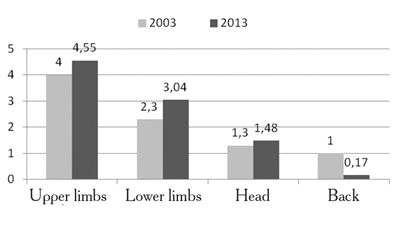
The intensity of injuries of different parts of upper limbs in players of national teams has a pretty big difference (Fig. 2). A slight decrease of muscle sprains by 8% and a significant decrease of shoulder injuries by 64% were accompanied by an increase of finger, elbow injuries and scratches by 60%, 65% and 48% respectively.
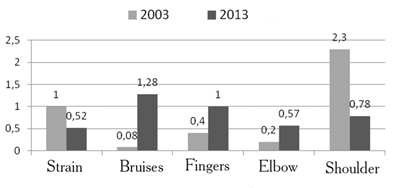
Fig. 2. Intensity of injuries of upper limbs among Russian women’s national team players in different years.
A large increase of knee and groin injuries by 65% and 76 % respectively was detected when comparing the indices of injuries of parts of lower limbs (Fig. 3).
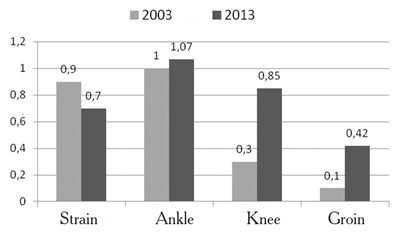
Fig. 3. Intensity of injuries of lower limbs among Russian women’s national team players
Modern female handball players got head injuries not so often by 16%, but bruises and wounds were found 29% more often (Fig.4). But the number of the most dangerous injury - concussion increased by 77%, among goalkeepers. One of them had concussion 4 times during the year.
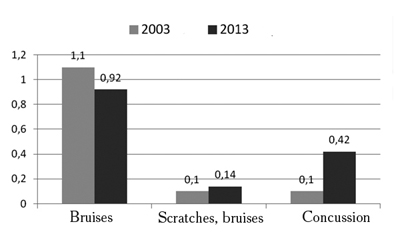
Fig. 4. Specifics of head injuries of Russian women’s national team players in different years
We can state that injuries of female handball players from the national team have increased significantly during the analyzed period. In fact, besides these injuries players have chronic injuries, which prevent the manifestation of skills for all they are worth. Five athletes out of 14 have chronic shoulder injury, three - knee, two - ankle, one elbow and back injuries. In addition, 3 most experienced handball players could not participate in qualification matches, because they were treated in a hospital or prepared for surgery. In 2003 female athletes did not have such serious states of spinal cord injuries. Frankly, the situation is oppressive.
Handball players responded differently to the question of injury causes, but the most important causes were: big load - 32%, unhealed injuries - 28% and court flooring - 24 % (Fig. 5).
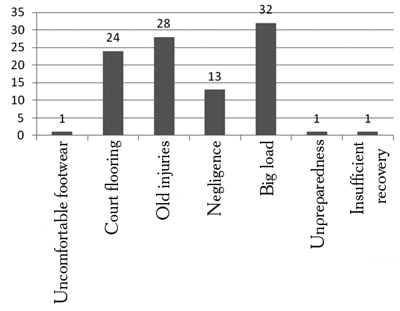
Fig. 5. The ratio of opinions of players of the national team on injury causes.
60 % of handball courts in Russia have wooden flooring, 10 % synthetic, 20% wood chipboard and 10% - Tarafleks (has a strong grip with players’ footwear, and with the expiration date, on the contrary, disposes to slipping and awkward movements)
Uncomfortable footwear Court flooring Old injuries Negligence Big load Unpreparedness Insufficient recovery
Conclusions. The measures that can prevent injuries among the players of the country’s national team include:
- enhancement of the organization of the training process and increase in control by the coaching council of the Russian handball federation of training of the national team both as a club and as a national team;
- the use and observance of the rules of player's post-workout recovery;
- elimination of the faults in the national competition schedule in view of capacities of keeping players in shape when performing as a national team.
References
- Ignat'ev, A.A. Educational aspects of injuries prevention among female handball players at the phases of sports perfection: Ph.D. thesis; RSUPhC / A.A. Ignat'ev. – Moscow, 2004. (In Russian)
- Ignat'eva, V.Ya. Handball. Textbook for universities of physical education / V.Ya. Ignat'eva. – Moscow: Fizicheskaya kultura, 2008 – 375 P. (In Russian)
- Ignat'eva, V.Ya. Women's handball between the past and the future / V.Ya. Ignat'eva // Teoriya i praktika fizicheskoy kultury. – 2003. – № 3. – P. 28–30. (In Russian)
Author’s contacts: Otrada116@mail.ru


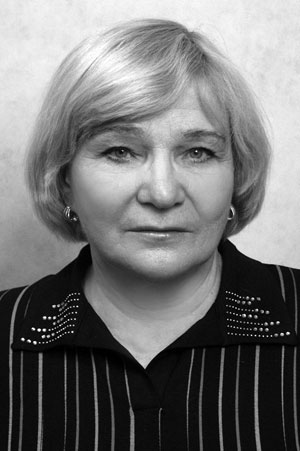

 Журнал "THEORY AND PRACTICE
Журнал "THEORY AND PRACTICE